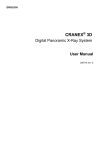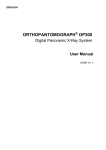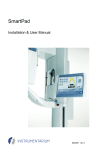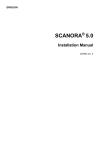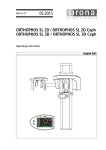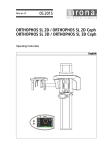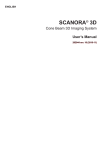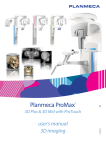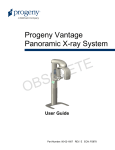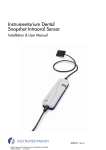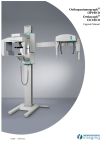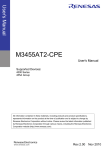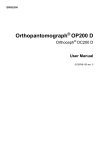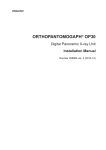Download CRANEX 3D
Transcript
ENGLISH CRANEX® 3D 3D Dental Imaging System User’s Manual 206718 rev. 4 Copyright Code: 206718 rev 4 Date: 20 June 2012 Document code: D506689 rev 4 Copyright © 06/2012 by PaloDEx Group Oy. All rights reserved. SOREDEX®, SCANORA® and CRANEX® are registered trademarks of SOREDEX, PaloDEx Group Oy. Other product names and trademarks are the property of their respective owners. CE marked (NB 0537). Windows® is trademark of Microsoft Corporation in the United States of America and other countries. Electric safety according to IEC 60601-1. Manufacturing complies with ISO 13485:2003, ISO 9001:2008 and ISO 14001:2004. DICOM® is the registered trademark of the National Electrical Manufacturers Association for its standards publications relating to digital communications of medical information. Documentation, trademark and the software are copyrighted with all rights reserved. Under the copyright laws the documentation may not be copied, photocopied, reproduced, translated, or reduced to any electronic medium or machine readable form in whole or part, without the prior written permission of SOREDEX. The original language of this manual is English. SOREDEX reserves the right to make changes in specification and features shown herein, or discontinue the product described at any time without notice or obligation. Contact your SOREDEX representative for the most current information. Manufactured by SOREDEX, PaloDEx Group Oy Nahkelantie 160 (P.O. Box 148) FI-04300 Tuusula FINLAND Tel. +358 10 270 2000 Fax. +358 9 701 5261 For service, contact your local distributor. Table of Contents 1 Introduction.................................................................................................................. 1 ® 1.1 CRANEX 3D....................................................................................................... 1 1.2 Intended use ......................................................................................................... 1 1.3 About this manual ................................................................................................. 2 1.4 Abbreviations used in this manual ........................................................................ 2 1.5 Associated documentation .................................................................................... 2 1.6 Warnings and precautions .................................................................................... 3 1.7 Manufacturer’s liability........................................................................................... 6 2 Unit description ........................................................................................................... 7 2.1 Main parts and controls......................................................................................... 7 2.2 Patient positioning lights ..................................................................................... 10 2.3 Patient positioning panel ..................................................................................... 13 2.4 Emergency stop switch ....................................................................................... 14 2.5 Imaging programs ............................................................................................... 15 2.5.1 Panoramic programs................................................................................ 15 2.5.2 Cephalometric programs.......................................................................... 18 2.5.3 3D programs ............................................................................................ 20 2.5.4 Exposure settings for 3D imaging ............................................................ 20 3 Controlling the unit.................................................................................................... 23 3.1 ClearTouchTM control panel ................................................................................ 23 3.2 Modality section .................................................................................................. 24 3.3 Sectional imaging................................................................................................ 24 3.4 Automatic Exposure setting (AES)...................................................................... 25 3.4.1 AES values for Panoramic imaging.......................................................... 25 3.4.2 AES values for Cephalometric imaging.................................................... 26 3.4.3 Exposure indicators and settings ............................................................. 27 3.5 Status section...................................................................................................... 27 3.6 Other sections ..................................................................................................... 28 4 Using the unit............................................................................................................ 29 4.1 Attaching and removing the sensor..................................................................... 29 4.1.1 Attaching the sensor ................................................................................ 29 4.1.2 Removing the sensor ............................................................................... 30 4.2 Preparing the system .......................................................................................... 30 4.3 Panoramic exposures ......................................................................................... 31 4.3.1 Positioning devices .................................................................................. 31 4.3.2 General instructions ................................................................................. 32 4.3.3 Patient positioning.................................................................................... 34 4.3.3.1 Panoramic exposure.................................................................. 34 4.3.3.2 TMJ exposure ............................................................................ 38 4.3.3.3 Maxillary Sinus exposure........................................................... 41 4.3.4 Taking the exposure................................................................................. 43 4.4 Cephalometric exposures ................................................................................... 45 4.4.1 General instructions ................................................................................. 45 4.4.2 Patient positioning.................................................................................... 47 4.4.2.1 Full width and reduced width projection..................................... 47 206718 rev 4 SOREDEX i 4.4.2.2 PA projection ............................................................................. 50 4.4.2.3 Reverse towne projection .......................................................... 52 4.4.2.4 Waters view ............................................................................... 54 4.4.2.5 Carpus view (Not in USA and Canada and Canada)................. 57 4.4.3 Taking the exposure................................................................................. 59 4.5 3D exposures ...................................................................................................... 60 4.5.1 Positioning devices .................................................................................. 60 4.5.2 General instructions ................................................................................. 61 4.5.3 Scout image ............................................................................................. 65 4.5.4 3D image.................................................................................................. 67 4.6 Warnings and error messages ............................................................................ 68 4.6.1 Acknowledging errors............................................................................... 68 4.6.2 Image transfer errors................................................................................ 68 5 Troubleshooting ........................................................................................................ 69 5.1 Patient positioning............................................................................................... 69 5.2 Image appearance .............................................................................................. 72 5.3 Artefacts .............................................................................................................. 73 5.4 Unit operation...................................................................................................... 75 6 Maintenance ............................................................................................................... 77 6.1 Maintenance procedure ...................................................................................... 77 6.1.1 Performing calibrations ............................................................................ 77 6.1.2 Preparing for calibration ........................................................................... 78 6.1.3 Panoramic calibration and quality check.................................................. 79 6.1.3.1 Panoramic geometry calibration ................................................ 79 6.1.3.2 Panoramic pixel calibration........................................................ 80 6.1.3.3 Panoramic Quality Check (OPTIONAL)..................................... 81 6.1.4 3D calibration and quality check .............................................................. 81 6.1.4.1 3D geometry calibration............................................................. 81 6.1.4.2 3D pixel calibration .................................................................... 82 6.1.4.3 3D Quality Check....................................................................... 83 6.2 Changing the fuses ............................................................................................. 86 6.3 Cleaning and disinfecting the unit ....................................................................... 87 6.4 Disposal .............................................................................................................. 89 7 Technical data............................................................................................................ 91 7.1 Technical specifications ...................................................................................... 91 7.2 Unit dimensions................................................................................................. 102 7.3 Symbols that appear in the unit......................................................................... 103 7.4 Labels on the unit.............................................................................................. 105 7.5 Unit identification labels .................................................................................... 106 7.6 Electromagnetic Compatibility (EMC) tables..................................................... 107 7.7 X-ray tube assemblies....................................................................................... 112 ii SOREDEX 206718 rev 4 1 Introduction 1.1 CRANEX® 3D SOREDEX CRANEX® 3D (hereafter called “the unit”) is a high quality dental imaging system designed to take images of the dento-maxillo-facial complies of the human skull. In order to take images with the unit you need a suitable PC hardware connected to the unit and SCANORA® software to manage images. The unit performs the following procedures: Pan Adult panoramic Child panoramic (Reduced width and height) Bitewing TMJ, PA projection TMJ, lateral projection (axially corrected) Maxillary sinus Ceph (optional) Cephalometric Full size Lateral Cephalometric Reduced size lateral Cephalometric posterior-anterior projection PA / AP Reverse Towne projection Waters view Carpus (Not in USA and Canada and Canada) 3D (optional) XS 61x41 mm Field of View Midi 61x78 mm Field of view 1.2 Intended use The unit must only be used and operated by dentist and other qualified professionals. The unit must only be used to take panoramic, cephalometric and 3D images of the dento-maxillofacial complex of the human skull. It must not be used to take images of any other part of the human body. Note that panoramic and 3D exposures should not be used if conventional intraoral radiographic images (bitewing exposures) would suffice. Note that cone beam computerized tomography images are not adequate for the analysis of soft tissue. 206718 rev 4 SOREDEX 1 1 Introduction USA only CAUTION! Federal law restricts this device to sale by or on the order of a dentist or other qualified professional. 1.3 About this manual This manual describes how to set up and use the unit. Please read this user’s manual before operating the unit for the first time. CAUTION! It is important to read the warnings and precautions, listed in section 1.6, before operating the unit for the first time. It is also important to observe these warnings and precautions whenever the unit is used. 1.4 Abbreviations used in this manual FOV = Field Of View. The cylindrical 3D volume that is reconstructed by the system. ROI = Region Of Interest. The anatomical area or region of the patient that you are interested to examine. ACS = Automatic Collimator Selector AES = Automatic Exposure Setting 1.5 Associated documentation The SCANORA® software user’s manual or the user’s manual for the dental imaging software you are using. The user’s instructions supplied with the 3D imaging software you are using. 2 SOREDEX 206718 rev 4 1 Introduction 1.6 Warnings and precautions To be observed during use 206718 rev 4 There should be free space around the unit for safe operation. The unit must only be used to take the dental x-ray exposures described in this manual. The unit must NOT be used to take any other x-ray exposures. It is not safe to use the unit to take an x-ray exposures, that it is not designed for. Only professionally qualified dental and/or medical personnel are allowed to operate the unit and carry out any diagnoses based on output from the unit. The personnel operating the device must be adequately trained in CBCT technology with respect to principles of operation and radiation protection. The unit may be dangerous to the user and the patient, if the safety regulations in this manual are ignored, if the unit is not used in the way described in this manual and/or if the user does not know how to use the unit. This unit complies with the EMC (Electromagnetic Compatibility) according to IEC 60601-1-2. Radio transmitting equipment, cellular phones etc. shall not be used in close proximity of the unit as they could influence the performance of the unit. Because the x-ray limitations and safety regulations change from time to time, it is the responsibility of the user to make sure that all the valid safety regulations are fulfilled. In all examinations the user of the x-ray equipment should wear protective clothing. The operator does not need to be close to the patient during normal use. The protection against stray radiation can also be achieved by using the hand switch not less than 2 m (7 ft) from the focal spot and the xray beam. Operator should maintain visible contact with the patient and Technical factors. This allows immediate termination of radiation by the release of the exposure button in the event of a malfunction or disturbance. It is the responsibility of the doctor to decide if the x-ray exposure is necessary. SOREDEX 3 1 Introduction The minimum height of patient that can be imaged is 120 cm (3.9 ft / 47.2) and the maximum is 200 cm (6ft / 78in). These heights only apply to patients with normal anatomy. When taking an x-ray exposure of a patient with exceptional anatomy (typically very tall or large) use the test mode (no x-rays) first to make sure that patient can be positioned correctly to the unit. Always use the lowest suitable x-ray dose to obtain the desired level of image quality. Avoid taking x-ray exposures of pregnant women. When taking an x-ray exposure of a child always use the lowest possible x-ray dose, the smallest possible image area and the lowest possible resolution that allows you to perform the required diagnostic task. If the patient is using a pacemaker, consult the manufacturer of the pacemaker before taking an exposure to confirm that the x-ray unit will not interfere with the operation of the pacemaker. Always use available disposable protective covers with the patient positioning accessories: Bite block cover Chin rest cover Ear holder cover 4 Disinfect all the surfaces that the patient is in contact with after every patient. Panoramic and 3D should not be used for routine or screening examinations in which a radiograph is taken regardless of the presence or absence of clinical signs and symptoms. 3D imaging examinations must be justified for each patient to demonstrate that the benefits outweigh the risks. Where it is likely that evaluation of soft tissues will be required as part of the patient’s radiological assessment, the imaging should be done using conventional medical CT or MR, rather than 3D imaging using Cone Beam technology. SOREDEX 206718 rev 4 1 Introduction General warnings 206718 rev 4 There should be enough space around the installation place of the unit. The place where the unit is to be installed and the position from where the user will take exposures must be correctly shielded from the radiation that is generated when the unit is operated. The unit or its parts must not be changed or modified in any way without approval and instructions from SOREDEX. When servicing use only approved replacement parts supplied by SOREDEX. The Ethernet cable shall be unshielded CAT6, so that multiple chassis are not connected. If this device is used with 3rd party imaging application software not supplied by SOREDEX, the 3rd party imaging application software must comply with all local laws on patient information software. This includes the Medical Device Directive 93/42/EEC and/or relevant legal requirements in the USA. Do not connect any equipment to the unit that has not been supplied with the unit or that is not recommended by SOREDEX. The use of accessory equipment not complying with the equivalent safety requirements of this equipment may lead to a reduced level of safety of the resulting system. The aperture plate and tubehead housing are made of lead (Pb), which is a toxic material. Do not touch these parts with your bare hands. The unit must be installed according to the unit installation & Adjustments manual by a qualified technician. This product itself complies IEC 60601-1 medical safety standard but in order to the system incorporating also a PC to comply the standard, EITHER the PC has to be a medical PC OR the PC has to be located over 1,5 meters apart from the unit. The installer and the user of the system shall confirm that at least one of the above requirements is fulfilled. A PC is a medical one if it complies IEC 60601-1 standard and that is indicated in the accompanying documents of the PC. All service operations are performed by SOREDEX authorized service personnel. SOREDEX 5 1 Introduction 1.7 Manufacturer’s liability As a manufacturer we can only assume liability of safe and reliable operation of this unit when – The unit installation was performed according to the unit Installation & Adjustments Manual by qualified CRANEX® dealer and – The unit is used according to the unit User Manual – SCANORA® PC software was installed according to the Installation Manual for SCANORA® software. – SCANORA® software is used according to User Manual for SCANORA® software. – Maintenance and repairs are performed by a qualified CRANEX® Dealer – Original or authorized spare parts are used In order to guarantee maximal image quality for the entire life time of this high performance imaging system, we suggest that a special image quality assurance procedure (* and test object designed for image quality assurance purposes is used. Also we recommend that a qualified serviceman to check the unit to be in its original condition regarding electrical, radiation and mechanical safety according to our maintenance program described in more details in maintenance manual every year or after 2000 images. For more information please contact your local dealer. *) According to EN61223-3-4 and DIN 6868-151 If service on the unit is performed, a work order describing the type and extent of repair must be provided by the service technician. This must contain information of changes of nominal data or work range performed. The work order must furthermore indicate the date of repair, the name of the company concerned and a valid signature. User should keep this work order for future references. 6 SOREDEX 206718 rev 4 2 Unit description 2.1 Main parts and controls 1. Column 2. Carriage 3. Main support 4. Rotating unit 5. On / off switch (rear of column) and main fuses 6. Tubehead assembly 7. ClearTouchTM control panel 8. Positioning panel 9. Sensor head 10. Head support 11. Chin rest 12. Handles 13. Cephalometric unit 14. Cephalometric sensor 15. Secondary collimator 16. Positioning panel 206718 rev 4 SOREDEX 7 2 Unit description Fig 2.1. On / off switch and main fuses PC with MDD approved dental imaging software and 3D viewing software. All software must conform to the MDD and the relevant legal requirements in the USA. 8 SOREDEX 206718 rev 4 2 Unit description 206718 rev 4 1. Sensor holder (PAN units only) 2. Panoramic sensor 1. 3D sensor (units with 3D option) 2. Panoramic sensor SOREDEX 9 2 Unit description 2.2 Patient positioning lights ‘ 10 1. Midsagittal 2. Frankfort-horizontal 3. Focal trough 4. Cephalometric Frankfort horizontal 5. Horizontal, top of FOV (3D option only) 6. Horizontal, bottom of FOV (3D option only) SOREDEX 206718 rev 4 2 Unit description Panoramic lights 206718 rev 4 1. Midsagittal light 2. Frankfort-horizontal plane 1. Focal trough light SOREDEX 11 2 Unit description Cephalometric lights 1. Frankfort-horizontal plane 3 D lights 12 1. Midsagittal light 2. Horizontal light, top of FOV 3. Horizontal light, bottom of FOV SOREDEX 206718 rev 4 2 Unit description 2.3 Patient positioning panel 206718 rev 4 1. Carriage UP / DOWN (Z-movement) 2. Focal trough adjustment (Y-movement) 3. Positioning lasers ON/OFF 4. Return 5. Chin support UP / DOWN SOREDEX 13 2 Unit description 2.4 Emergency stop switch In case of malfunction of the exposure button or other protective devices of the unit, an emergency stop switch is provided near the handles and on the roof of the cephalostat head so that the patient can reach it. If the emergency stop switch is pressed during an exposure, the exposure is terminated immediately and the x-ray unit is completely stopped. An interrupted exposure cannot be continued later, but has to be retaken from the beginning. Press to stop the unit, rotate to release. 14 SOREDEX 206718 rev 4 2 Unit description 2.5 Imaging programs 2.5.1 Panoramic programs Adult: Magnification 1.3 Panoramic imaging provides general view of dental and facial anatomy based on panoramic imaging technic. Adult panoramic 20,5 cm width x 11 cm height. Child: Magnification 1.3 Child panoramic 11,5 cm width x 8,5 height. Child panoramic has reduced width and height. Children can be imaged with less radiation dosage and shorter exposure time. Patients with jaw more narrow than average jaw can be exposed with this too. 206718 rev 4 SOREDEX 15 2 Unit description Bitewing: Magnification 1.3 An orthogonal view of the dentition from the canine and posterior. Lateral TMJ: Magnification 1.23 a b Lateral TMJ program provides a wide layer axially corrected views for the patient's left and right temporomandibular joints. PA TMJ: Magnification 1.55 16 SOREDEX 206718 rev 4 2 Unit description Maxillary Sinus: Magnification 1.3 Mesial 10 mm Start Distal 10 mm Maxillary Sinus program produces a pan - tomographic layer through the posterior maxillary sinus. The layer is flatter than the standard panoramic programs and is moved 18 mm backward. These images are helpful in visualizing the mid and posterior maxillary sinus. 206718 rev 4 SOREDEX 17 2 Unit description 2.5.2 Cephalometric programs Cephalometric programs provide central projection images of patient skull and dental anatomy. Images are utilized in ortodontics and general diagnostics. Full size lateral: Magnification 1.15 Field size: 22 x 26 cm (height x wide). Lateral Cephalostat uses a full height image field. Reduced size lateral Field size: 22 x 18 cm (height x wide). Reduced Width Lateral program has an optimized image width that is used e.g. for pediatric patients but also adult patients to reduce the radiation dose. 18 SOREDEX 206718 rev 4 2 Unit description Cephalometric posterior-anterior (PA): Magnification 1.15 PA 22 x 20 cm (height x wide) Carpus view (Not in USA and Canada and Canada) 206718 rev 4 SOREDEX 19 2 Unit description 2.5.3 3D programs Cone beam 3D imaging enables seeing dentomaxillofacial anatomy of selected Field of View, FOV, helping with diagnostics and treatment planning. With 3D viewing software, user is able to analyze FOV area from multiple directions and see cross-sectional images from the area of interest. XS FOV 61 x 41 mm (height x diameter) High resolution Standard resolution Midi size FOV 61 x 78 mm (OPTIONAL) Standard resolution or High resolution. High resolution Standard resolution 2.5.4 Exposure settings for 3D imaging 20 SOREDEX 206718 rev 4 2 Unit description Exposure settings for 3D imaging NOTE! Voltage settings is always 90kV with unit 3D modality. Resolutio n FOV (h x w) High Res 61 x 41 mm 6,1 s 10 s Amount of projectio ns 608 Std Res 61 x 41 mm 2,3 s 10 s 230 High Res 61 x 78 mm 12,6 s 20 s 1260 Std Res 4,9 s 20 s 460 61 x 78 mm Exposur Scanning e time time mA mA mA Low dose High-quality High-quality (DAP (DAP (DAP mGycm2) mGycm2) mGycm2) 6.3 mA 8 mA 13 mA (298) (379) (593) 8 mA 10 mA 13 mA (145) (181) (227) 5 mA 6.3 mA 10 mA (491) (619) (983) 8 mA 10 mA 13 mA (302) (372) (472) DAP values vary from unit to unit in relation to the x-ray tube output. Thus above values indicate average DAP values. In addition to these recommended values, there is a possibility to use the whole mA range if the user prefers. Available mA ranges for each field of view sizes and resolution settings Resolution FOV 4 mA 5 mA 6.3 mA 8 mA 10 mA 13 mA (h x w) (DAP) High Res 61 x 41 mm x x x x x x Std Res 61 x 41 mm x x x x High Res 61 x 78 mm x x x x x Std Res 61 x 78 mm x x x x Exposure settings for scout imaging (default values) Resolution FOV kV mA Scannin (h x w) g time Scout 61 x 41 mm 90 13 0,02 s Scout 61 x 78 mm 90 13 0,04 s 206718 rev 4 SOREDEX 21 2 Unit description 22 SOREDEX 206718 rev 4 3 Controlling the unit 3.1 ClearTouchTM control panel 206718 rev 4 1. Modality selection 2. Program selection 3. Imaging values 4. Imaging area 5. Status of the unit 6. Test mode 7. Settings 8. Case end SOREDEX 23 3 Controlling the unit 3.2 Modality section Select the modality button PAN, CEPH or 3D. When panoramic modality is selected, a program specific dental arch is shown. This can be used for partial panoramic imaging. Cephalometric programs have their own, program specific image figures and setting buttons for the start position of lateral scanning. 3D programs (two FOV sizes) have buttons for selecting low resolution, High resolution or scout image mode. The FOV for 3D imaging can be positioned on the XY-plane by selecting the center point of the FOV on the dental arch of the ClearTouch control panel. The FOV is positioned in the Z-direction by using the chin rest movement and positioning lights. 3.3 Sectional imaging Dental arch on the touch panel shows the enabled and disabled arch sections from the result point of view. Select the image area from the dental arch. 24 SOREDEX 206718 rev 4 3 Controlling the unit 3.4 Automatic Exposure setting (AES) AES automatically recommends the exposure values according to the size of the patient’s head in panoramic and cephalometric imaging. The AES is activated with active A button and by pushing Return button once. The AES suggest exposure values based on patient size. The user can change the value before exposure if needed by pushing A button again and changing the values. 3.4.1 AES values for Panoramic imaging NOTE! Values can be re-scaled by SOREDEX authorized service personnel. Adult, child panoramic, Bitewing, Sinus Head width (min) kV mA 19,3 cm (Max) 15,9 cm 14,2 cm 13,35 cm 12,925 cm 12,5 cm (Min) 70 70 70 66 66 66 13 10 8 8 6,3 5 AES values for TMJ Lat/PA 206718 rev 4 Head width (min) kV mA 19,3 cm (Max) 15,9 cm 14,2 cm 13,35 cm 12,925 cm 12,5 cm (Min) 73 73 73 73 73 73 16 13 10 8 6,3 5 SOREDEX 25 3 Controlling the unit 3.4.2 AES values for Cephalometric imaging Lat/PA 100 V Head width (min) kV mA s 17,3 cm (Max) 14,45 cm 12,65 cm 11,45 cm 10,55 cm 6,5 cm (Min) 90 90 90 90 90 85 8 8 8 8 8 8 20 20 16 12,5 10 10 Ceph Lat/PA 120 V Head width (min) kV mA s 17,3 cm (Max) 14,45 cm 12,65 cm 11,45 cm 10,55 cm 6,5 cm (Min) 90 90 90 90 90 85 10 10 10 10 10 8 20 20 16 12,5 10 10 Ceph Lat/PA 240 V 26 Head width (min) kV mA s 17,3 cm (Max) 14,45 cm 12,65 cm 11,45 cm 10,55 cm 6,5 cm (Min) 90 85 85 85 85 85 12,6 12,6 12,6 12,6 10 8 16 16 12,5 10 10 10 SOREDEX 206718 rev 4 3 Controlling the unit 3.4.3 Exposure indicators and settings kV value mA value Exposure time (s) Dose value (mGycm2) Focal through light (mm) Focal through light y-layer position Test mode Automatic Exposure setting (AES) 3.5 Status section Status field shows when the unit is ready for capturing or any trouble occurs. Green and yellow colour indicate the status in question. Ready for imaging 206718 rev 4 SOREDEX 27 3 Controlling the unit 3.6 Other sections General settings - User programs Info Languages Quality assurance Retrieve last image Exposure settings 28 SOREDEX 206718 rev 4 4 Using the unit 4.1 Attaching and removing the sensor WARNING! Handle the sensor with care as instructed in this manual. The sensor must not be dropped or exposed to impacts. A shock indicator inside the sensor shows if the sensor has been exposed to excess impact. 4.1.1 Attaching the sensor 206718 rev 4 1. Insert the four slots on the rear of the sensor, into the four hooks in the sensor holder. 2. Slide the sensor downwards until it stops and then slide the locking knob down on the side of the sensor to lock the sensor in position. SOREDEX 29 4 Using the unit 4.1.2 Removing the sensor 1. Slide the locking knob upwards on the side of the sensor to unlock the sensor. 2. Slide the sensor up and remove it. 4.2 Preparing the system 30 1. Switch on the unit and the PC. 2. PC: Start SCANORA® application). 3. PC: Open a new or existing patient or select a patient from the worklist. See the user’s guide supplied with the dental imaging program. SOREDEX software (or 3rd party 206718 rev 4 4 Using the unit 4.3 Panoramic exposures Adult panoramic Child panoramic (Reduced width and height) Bitewing Maxillary sinus TMJ, PA/AP projection TMJ, lateral projection (axially corrected) 4.3.1 Positioning devices Bite block Chin rest holder 206718 rev 4 Chin plane TMJ support Lip holder for edentulous patients SOREDEX Chin cup 31 4 Using the unit 4.3.2 General instructions 32 1. PC: Click Image Capture. 2. Select panoramic imaging. 3. Select the imaging program. 4. Any section of the dental arc can be selected for the sectional imaging to limit exposure area and reduce the radiation dosage. SOREDEX 206718 rev 4 4 Using the unit 5. Press the Return button to rotate the unit to ‘patient in’ position. 6. Open the temple supports. 1 Temple support knob 2 Forehead support 3 Temple supports 7. 206718 rev 4 Ask the patient to remove any spectacles, hearing aids, removable dentures, jewellery and hair clips and pins. Place a protective lead apron on the patient. SOREDEX 33 4 Using the unit 4.3.3 Patient positioning 4.3.3.1 1. Panoramic exposure Insert the chin rest and bite rod with the bite block. Place the disposable covers. NOTE! Use a new disposable cover for every patient. 2. Adjust the unit height. 3. Guide the patient to the unit and instruct to stand as straight and tall as possible. Exposure can be taken also in sitting position. Ask the patient to take grip on the handles and bite on the bite block. Use the lipholder or the chin support for an edentulous patient. 4. Ask the patient to take one step forward to straighten the spinal column. Patient is slightly leaning backwards during the imaging. 5. Check the position of the midsagittal light. If it is not on the midsagittal plane of the patient, adjust the patient’s head. Fig 4.1. bite block and lip holder 34 SOREDEX 206718 rev 4 4 Using the unit Make sure the patient’s head is not turned or tilted. 6. 206718 rev 4 Adjust the height of the Frankfort-Horizontal plane (FH) laser to get the laser light over the orbita porion. Straighten the patient's head if needed. SOREDEX 35 4 Using the unit 7. Close the temple supports by sliding the temple support knob to the right (A). Adjust the position of the nasion support (B) and push the forehead support in until it touches the patient’s nasion (C). 8. The focal trough light indicates the center of the focal trough, which is 10 mm wide at the front. The root apices of the patient’s central upper and lower front incisors must be within the focal trough. Ask the patient to open their lips so that you can see their teeth. The focal trough light should be positioned slightly in front of the root apices, which for most patients will be in the middle of 3rd tooth (canine). If the patient is edentulous the focal trough light should be approximately 5mm behind the lip holder when the focal trough position is 0 mm. 36 SOREDEX 206718 rev 4 4 Using the unit NOTE! If the focal trough light is not positioned as described above, press the focal trough adjustment key(s) to move the focal trough light until it is positioned correctly. Fig 4.2. Focal trough light position indicator 9. If AES is enabled (green light lit around "A"), press the Return button and wait for the movement to finish. Verify that the suggested exposure values are suitable for the patient. If AES is disabled, set the exposure values manually and press Return to drive the unit into exposure start position (optional). 10. Ask the patient to press their tongue against the roof of their mouth, swallow and remain still for the duration of the exposure. 206718 rev 4 SOREDEX 37 4 Using the unit 4.3.3.2 1. TMJ exposure Insert the required positioning devices, including the TMJ support. Place the disposable covers. NOTE! Use a new disposable cover for every patient. 38 2. Adjust the unit height. 3. Guide the patient to the unit and instruct to stand as straight and tall as possible. Ask the patient to take grip on the handles and set the mouth against the lip holder. 4. TMJ lateral projection: Adjust the height of the Frankfort-Horizontal plane (FH) laser to get the laser light over the orbita porion. Straighten the patient's head if needed. SOREDEX 206718 rev 4 4 Using the unit 206718 rev 4 5. TMJ PA/AP projection: Tilt the patient’s head forward. 6. Check the position of the midsagittal light. If it is not on the midsagittal plane of the patient, adjust the patient’s head. 7. Close the temple supports by sliding the temple support knob to the right. Adjust the position of the nasion support and push the forehead support in until it touches the patient’s nasion. SOREDEX 39 4 Using the unit 8. Adjust the position of the TMJ light until it aligns in the middle of condyle. NOTE! The condyle moves forward by approximately 10 mm when the mouth is opened" 9. If AES is enabled (green light lit around "A"), press the Return button and wait for the movement to finish. Verify that the suggested exposure values are suitable for the patient. If AES is disabled, set the exposure values manually and press Return to drive the unit into exposure start position (optional). 10. Ask the patient to press their tongue against the roof of their mouth, swallow and remain still for the duration of the exposure. 40 SOREDEX 206718 rev 4 4 Using the unit 4.3.3.3 1. Maxillary Sinus exposure Insert the the lip holder for sinus imaging. Place the disposable covers. NOTE! Use a new disposable cover for every patient. 2. Adjust the unit height. 3. Guide the patient to the unit and instruct to stand as straight and tall as possible. Ask the patient to take grip on the handles and set the mouth against lip holder. 4. Check the position of the midsagittal light. If it is not on the midsagittal plane of the patient, adjust the patient’s head. 5. Adjust the height of the Frankfort-Horizontal plane (FH) laser to get the laser light over the orbita porion. Straighten the patient's head if needed. 6. Close the temple supports by sliding the temple support knob to the right. Adjust the position of the nasion support and push the forehead support in until it touches the patient’s nasion. 7. Adjust the position of the image layer as necessary. The focal trough light should be positioned in the middle of the 3rd tooth or if wanted slightly posterior. NOTE! If the focal trough light is not positioned as described above, press the focal trough adjustment key(s) to move the focal trough light until it is positioned correctly. 206718 rev 4 SOREDEX 41 4 Using the unit 42 8. If AES is enabled (green light lit around "A"), press the Return button and wait for the movement to finish. Verify that the suggested exposure values are suitable for the patient. If AES is disabled, set the exposure values manually and press Return to drive the unit into exposure start position (optional). 9. Ask the patient to press their tongue against the roof of their mouth and remain still for the duration of the exposure. SOREDEX 206718 rev 4 4 Using the unit 4.3.4 Taking the exposure WARNING! Close the patient positioning mirror before taking any exposures. 1. Ask the patient to remove any spectacles, dentures, jewellery and hair clips and pins. Ensure that the patient’s thyroid glands are protected by a lead apron during exposure. 2. Press Return. Check the patient positioning. Protect yourself from radiation by standing behind a suitable x-ray radiation shield. Make sure that you can see and hear the patient during the exposure. NOTE! In all examinations the user of the x-ray equipment should wear protective clothing. The operator does not need to be close to the patient during normal use. The protection against stray radiation can be achieved by using the hand switch not less than 2 m (7 ft) from the focal spot and the xray beam. Operator should maintain visible contact with the patient and Technical factors. This allows immediate termination of radiation by the release of the exposure button in the event of a malfunction or disturbance. NOTE! If the patient is nervous, or a child, you can demonstrate how the unit works to reassure them. Press the T (Test mode) button and then press and hold the exposure button. The unit will complete an exposure cycle without generating x-rays. 206718 rev 4 SOREDEX 43 4 Using the unit 44 3. Press and hold down the exposure button. During the exposure you hear an audible signal and the exposure warning symbol on the ClearTouchTM control panel appears. The unit rotates around the patient’s head and stops. When the rotating unit stops, the exposure has been taken. 4. After the exposure the rotating unit is in ‘patient out’ position, if the exposure switch has been pressed until all movements have stopped. Release temple supports. Guide the patient out. Remove disposable covers and disinfect the unit. 5. PC: The image can be examined using the SCANORA® software. See SCANORA® software user’s manual. SOREDEX 206718 rev 4 4 Using the unit 4.4 Cephalometric exposures Reduced Width lateral projection Lateral projection PA/AP projection Reverse towne projection Waters view Carpus view (Not in USA and Canada and Canada) 4.4.1 General instructions 206718 rev 4 1. Move the ceph sensor to the ceph sensor holder in a case of single sensor configuration.. 2. PC: Click Image Capture. 3. Select CEPH. 4. Select the imaging program. SOREDEX 45 4 Using the unit 46 5. If AES is enabled (green light lit around "A"), press the Return button and wait for the movement to finish. Verify that the suggested exposure values are suitable for the patient. If AES is disabled, set the exposure values manually and press Return to drive the unit into exposure start position (optional). 6. Press the Return button to drive the unit to ‘patient in’ position. 7. Ask the patient to remove any spectacles, hearing aids, removable dentures, jewellery and hair clips and pins. Place a protective lead apron on the patient. SOREDEX 206718 rev 4 4 Using the unit 4.4.2 Patient positioning 4.4.2.1 206718 rev 4 Full width and reduced width projection SOREDEX 47 4 Using the unit 1. Unlock the lever and turn the ear rods to the lateral projection position. Lock the position. 2. Place the disposable covers. NOTE! Use a new disposable cover for every patient. 48 3. Adjust the unit height. 4. Guide the patient to the unit. Instruct the patient to stand as straight and tall as possible under the cephalostat head. Slide the ear rods towards to patient’s ears. SOREDEX 206718 rev 4 4 Using the unit 206718 rev 4 5. Adjust the patient head so that the Frankfort-Horizontal plane (FH) and laser light are in same horizontal plane. 6. Slide nasion support against patient’s nasion. SOREDEX 49 4 Using the unit 4.4.2.2 50 PA projection SOREDEX 206718 rev 4 4 Using the unit 1. Unlock the lever and turn the ear rods to the PA projection position. Lock the position. Tilt the nasion support aside. 2. Place the disposable covers. NOTE! Use a new disposable cover for every patient. 206718 rev 4 3. Adjust the unit height. 4. Guide the patient to the unit facing the sensor. Instruct the patient to stand as straight and tall as possible under the cephalostat head. Slide the ear rods towards patient’s ears. SOREDEX 51 4 Using the unit 4.4.2.3 52 Reverse towne projection SOREDEX 206718 rev 4 4 Using the unit 1. Unlock the lever and turn the ear rods to the PA projection position. Lock the position. Tilt the nasion support aside. 2. Place the disposable covers. NOTE! Use a new disposable cover for every patient. 206718 rev 4 3. Adjust the unit height. 4. Guide the patient to the unit. Instruct the patient to stand as straight and tall as possible under the cephalostat head. 5. Turn the head ventral as reference to the canthomeatal line about 30° below the horizontal plane. 6. Slide the ear rods towards patient’s ears. 7. Ask the patient open mouth maximally. SOREDEX 53 4 Using the unit 4.4.2.4 54 Waters view SOREDEX 206718 rev 4 4 Using the unit 1. Unlock the lever and turn the ear rods to the PA projection position. Lock the position. Tilt the nasion support aside. 2. Place the disposable covers. NOTE! Use a new disposable cover for every patient. 206718 rev 4 3. Adjust the unit height. 4. Guide the patient to the unit. Instruct the patient to stand as straight and tall as possible under the cephalostat head. 5. Turn the head dorsal as reference to the canthomeatal line about 35-40° above the horizontal plane. 6. Slide the ear rods towards patient’s ears. SOREDEX 55 4 Using the unit 7. 56 Ask the patient open or close mouth. SOREDEX 206718 rev 4 4 Using the unit 4.4.2.5 206718 rev 4 Carpus view (Not in USA and Canada and Canada) SOREDEX 57 4 Using the unit CAUTION! Before taking Carpus image make sure this imaging method is approved by local authorities of your country. 58 1. Unlock the lever and turn the ear rods to the PA projection position. Lock the position. Tilt the nasion support aside. Place the carpus holder to the nasion support holder. 2. Adjust the unit height if needed. 3. Ask the patient to remove rings and metal objects and to place hand on the carpus holder. SOREDEX 206718 rev 4 4 Using the unit 4.4.3 Taking the exposure WARNING! Close the patient positioning mirror before taking any exposures. 1. Ask the patient to remove any spectacles, dentures, jewellery and hair clips and pins. Place a protective lead apron around the patient’s neck to protect the patient’s thyroid gland from radiation. 2. Protect yourself from radiation by standing behind a suitable x-ray radiation shield. Make sure that you can see and hear the patient during the exposure. 3. Press and hold down the exposure button. During the exposure you hear an audible signal and the exposure warning symbol on the ClearTouchTM control panel appears. 4. Release the ear rods and guide the patient out. Remove disposable covers and disinfect the unit. 5. PC: The image can be examined using the SCANORA® software. See SCANORA® software user’s manual. NOTE! In all examinations the user of the x-ray equipment should wear protective clothing. The operator does not need to be close to the patient during normal use. The protection against stray radiation can be achieved by using the hand switch not less than 2 m (7 ft) from the focal spot and the xray beam. Operator should maintain visible contact with the patient and Technical factors. This allows immediate termination of radiation by the release of the exposure button in the event of a malfunction or disturbance. 206718 rev 4 SOREDEX 59 4 Using the unit 4.5 3D exposures 4.5.1 Positioning devices Chin cup Bite block and chin plane 60 SOREDEX 206718 rev 4 4 Using the unit 4.5.2 General instructions 1. PC: Click Image Capture. 2. Select the 3D modality. The teeth locations on the 3D dental arch are approximate and are based on average dentition. The exact teeth locations will depend on the patient’s individual anatomy. The EasyScout function helps locate the correct dental location of the Field of view. 206718 rev 4 SOREDEX 61 4 Using the unit 62 3. Select the Field Of View (FOV): XS FOV 61 x 41 mm (Program 1) Midi FOV 61 x 78 mm (Program 2) (OPTIONAL) 4. Select the area of interest on the dental arch. The 3D FOV is positioned more accurately by using the scout image mode. The area of interest can be adjusted on the ClearTouchTM control panel after the scout image has been taken. 5. Press the Return button to rotate the unit to ‘patient in’ position. 6. Adjust the unit height. 7. Ask the patient to remove any spectacles, hearing aids, removable dentures, jewellery and hair clips and pins. 8. Guide patient to the unit. Instruct patient to stand as straight and tall as possible next to the unit. Patient can also be imaged in sitting position. Ask the patient to take grip on the handles and place chin on the chin cup. SOREDEX 206718 rev 4 4 Using the unit 9. Check the position of the midsagittal light. If it is not on the midsagittal plane of the patient, adjust the patient’s head. 10. Adjust the unit height and chin rest height to get the area of interest between the top and bottom FOV lights. Position the patient so that the occlusal plane is horizontal. 1. Horizontal light, top of FOV 2. Horizontal light, bottom of FOV NOTE! Target ROI is always in the middle plane of laser lights. 206718 rev 4 SOREDEX 63 4 Using the unit 11. Select the image area from the dental arch. 12. Close the temple supports by sliding the temple support knob to the right (A). Adjust the position of the nasion support (B) and push the forehead support in until it touches the patient’s nasion (C). 13. Select A the Scout image or B the Standard or High resolution 3D image 64 SOREDEX 206718 rev 4 4 Using the unit 4.5.3 Scout image WARNING! Close the patient positioning mirror before taking any exposures. 206718 rev 4 1. Press and hold down the exposure button. During the exposure you hear an audible signal and the exposure warning symbol on the ClearTouchTM control panel appears. 2. Scout preview image appears to the ClearTouchTM control panel. 3. Fine adjust scout position using the side arrow keys. Press the left lower corner icon to continue. SOREDEX 65 4 Using the unit 4. Take a new scout or save current and continue to 3D image. 5. Previous FOV position is shown as gray circle and new position is showed as green circle. NOTE! Gray circles remain in control panel until you change the patient. 66 SOREDEX 206718 rev 4 4 Using the unit 4.5.4 3D image 1. Select the Standard High resolution 2. or . Select mA. WARNING! Close the patient positioning mirror before taking any exposures. 3. 206718 rev 4 Press and hold down the exposure button. During the exposure you hear an audible signal and the exposure warning symbol on the ClearTouchTM control panel appears. SOREDEX 67 4 Using the unit 4.6 Warnings and error messages The unit responds to error situations by showing a dialog box containing an error code and descriptive text on the touch screen. When an error code appears on the display the unit will stop working and cannot be operated while the error code is on the display. In less severe cases a warning message will be displayed, leaving the unit operable. 4.6.1 Acknowledging errors Most errors may be acknowledged by closing the dialog box the error is reported in. Some errors require the unit to be rebooted. If such an error occurs, or if the unit fails to operate as described in the user's manual, switch the unit off, wait a few seconds and switch the unit on again. 4.6.2 Image transfer errors If an image is not transferred successfully to the PC, close and then reopen the dental imaging software and/or restart the PC. DO NOT restart the unit as this will erase any image that is stored in the unit memory and this retrievable image will be lost. 68 SOREDEX 206718 rev 4 5 Troubleshooting High quality images with sharp contrast and good detail provide optimum diagnostic information. Images with less quality are usually the result of one or more common problems. 5.1 Patient positioning Problem Incisors and canines narrow and unsharp. Overshadow in molar and premolar areas. Rows of teeth are compressed. Possible cause Remedy 1. Occlusal correction of focal 1. Check patient positioning with trough set too far posterior laser light lines and 2. Image layer laser light not occlusion correction obeyed buttons 3. Bite block was not 2. Check patient used positioning with laser light lines and occlusion correction buttons 3. Insert bite block AUP Problem Possible cause Remedy Incisors and canines wide 1. Occlusal correction of focal 1. Check patient positioning with laser trough set too far anterior and unsharp. Rows of light lines and teeth widened. 2. Image layer laser light occlusion correction not obeyed buttons 3. Bite block was not 2. Check patient used positioning with laser light lines and occlusion correction buttons ABACK 3. Insert bite block 206718 rev 4 SOREDEX 69 5 Troubleshooting Problem Possible cause Teeth appear wider on one 1. Midsagittal line not obeyed Remedy 1. Check patient's mid sagittal plane with laser light line side and narrower on the 2. Patient's head not in center opposite. Ramus widths are position 2. Check that patient's head is different on opposite sides. centered, and that the head support side clamps where closed to keep the head straight. Problem Possible cause The shadow of hard palate is Patient head tilted back exposed over maxillary molars. Row of teeth has a wavy appearance. TM joints are exposed outward. Image is not "smiling". Mandible is imaged sharper than maxilla. Remedy Check FH plane AUP Problem Possible cause Rows of teeth curved Patient head tilted forward upwards. Mandibular incisors are unsharp. TMJ joints exposed high and are often cut off from the image. Image is "smiling" too much. 70 SOREDEX Remedy Check FH plane 206718 rev 4 5 Troubleshooting Problem Middle area of the image too bright and unsharp. Spine shadow. Possible cause Patient's neck was not stretched Remedy Stretch patient's neck Possible cause Remedy ANECK Problem Black shadow over maxillary Tongue was not against the Ask patient to swallow and teeth apex area. roof of palate. place tongue against the roof of palate during the exposure. Problem Possible cause TMJ's exposed on different 1. Patient tilted to one side heights on image. Bilateral 2. Midsagittal laser light line distortion in molar and premolar not obeyed. regions. Problem Rows of teeth exposed too high. TMJ's cut off. Remedy 1. Check midsagittal plane and center patient's head. 2. Check midsagittal plane and center patient's head. Possible cause Remedy 1. Chin was not resting on chin 1. Check patient positioning and type of bite rod. support 2. Patient positioned too high 2. Check patient positioning and type of bite rod. Problem Possible cause Remedy Rows of teeth exposed too low. Chin rest was not used with bite Install chin rest. Mandible not exposed rod. completely to the image. 206718 rev 4 SOREDEX 71 5 Troubleshooting 5.2 Image appearance Problem Images are too light Possible cause Remedy 1. Adjust contrast and 1. SCANORA® software: brightness. Contrast and brightness not optimum 2. Select a more fitting histogram type and check ® 2. SCANORA software: gamma setting. Gamma not set correctly Problem Images are too dark Possible cause ® Remedy 1. Adjust contrast and density. 1. SCANORA software: Contrast and brightness not 2. Decrease Technical factors. optimum. 2. Manual Technical factors used too high. Problem Lack of image contrast Possible cause Remedy 1. Adjust contrast and 1. SCANORA software: brightness. Contrast and brightness not optimum. 2. Lower the kV setting. 2. kV used is too high. 3. Adjust Gamma value ® 3. Gamma value is not correct for the monitor being used. 72 SOREDEX 206718 rev 4 5 Troubleshooting 5.3 Artefacts Problem Irregular, bright shadows or artefacts Possible cause Patient is wearing metal objects, such as earrings, necklace etc. Remedy Ask patient to remove objects. Possible cause Lead apron misplaced. Remedy Check the lead apron positioning. AJEWEL Problem An unexposed area is shown down in the lower middle section of the image. AAP Problem Possible cause Partial lack of detail and motion Patient has moved during the artefacts. Irregular vertical exposure. bright lines on image. Problem Vertical dark lines on image. Remedy Retake the image. Possible cause Remedy Patient's shoulder in touch with Check patient positioning. machine parts. Problem Possible cause Patient's right side tooth are not Exposure button released exposured. prematurely. Remedy Retake the image. Problem Possible cause Right and left image sides are Orthogonal procedure was uncomplete. TMJ's are not mistakenly used. shown. Remedy Select correct panoramic procedure. 206718 rev 4 SOREDEX 73 5 Troubleshooting Problem A light horizontal line on QC image. Possible cause Bite block was left on place. Remedy Remove the bite block and retake QC image. Problem Horizontal lines on image. Possible cause Sensor problem. Remedy Consult the dealer. Problem CEPH: Lateral view has 2 ear holder pins. Possible cause Remedy 1. Cephalostat lock not locked 1. Lock it 74 2. Ear holders misaligned SOREDEX 2. Call service 206718 rev 4 5 Troubleshooting 5.4 Unit operation Problem Possible cause Back of the patient's head is 1. Patient's head inclination not touching the x-ray tube during correct the exposure. 2. Patient is too big for the unit. 3. Patient has slumped. Remedy If the image is not acceptable then 1. Check the head position and retake the image. 2. Check the patient positioning. Make the exposure even though the head may touch the tube head. 3. Check the patient positioning. Make the exposure even though the head may touch the tube head. Problem Patient's shoulders are touching the x-ray tube or sensor. 206718 rev 4 Possible cause Patient is too big for the unit. Wide and high shoulders. SOREDEX Remedy Reverse patient's hands on handles: left to right side handle and vice versa. 75 5 Troubleshooting 76 SOREDEX 206718 rev 4 6 Maintenance 6.1 Maintenance procedure The maintenance procedure described below shall be seen as a minimum requirement and can be made more stringent to comply with regulations regarding the use and maintenance of dental x-ray devices that are in force in the country in which the unit is installed. Annual maintenance An annual maintenance procedure must be carried out at least once a year by qualified service personnel. Contact your local distributor for details. Calibration intervals To keep the image quality at best possible level, calibrations and quality checks shall be carried out at regular intervals according to the table below. Modality Minimum requirement Recommendation 3D Two (2) times annually Four (4) times annually Panoramic Annually during normal maintenance Two (2) times annually Cephalometric Annually during normal maintenance Two (2) times annually NOTE! The calibrations mentioned in this manual can be done by the user or qualified service personnel. 6.1.1 Performing calibrations Calibrations and quality checks are performed by taking exposures of calibration tools. The system does needed adjustments according to the image data captured. For panoramic and cephalometric quality checks the quality is visually evaluated by the operator. Resulting from the each calibration is an image containing calibration results, telling the operator how to proceed with the calibration and adjustment procedure. In addition to the calibration name (e.g. Adjustment panCol) the images contain image data sampled during the calibration, 206718 rev 4 SOREDEX 77 6 Maintenance adjustment instructions and a "Passed / Not Passed / Failed" calibration status. – Passed means that the calibration program is successfully done. Move on to next calibration. – Not passed means that adjustment is still needed. Follow the instructions contained in the image (if any) and take another exposure. Some calibration programs are iterative and demand a few repetitions. – Failed means that the system could not decide what adjustment should be done in order for the calibration to succeed. This calibration status is always the result of some error condition. Contact service if the problem persists after restarting the unit and PC. 6.1.2 Preparing for calibration 78 1. Close the head support and lock it in its upmost position. 2. Switch the PC and unit on. 3. PC: Open the dental imaging sofware and then open a patient (card) and give it and identfiable name, for example: calibration (refer to the user’s manual supplied with the dental imaging software for more information). 4. PC: Click the image acquisition button to activate image capture. 5. Touch Settings on the Touch screen display. 6. Select Quality assurance. The calibration display appears. SOREDEX 206718 rev 4 6 Maintenance 6.1.3 Panoramic calibration and quality check 6.1.3.1 206718 rev 4 Panoramic geometry calibration 1. Select the program. 2. Press the return button. 3. Install the double cone calibration tool. 4. Take an exposure. Repeat the calibration until calibration result "passed" is achieved. SOREDEX 79 6 Maintenance 6.1.3.2 80 Panoramic pixel calibration 1. Remove calibration tools. 2. Select the program. 3. Press the return button. 4. Take an exposure. SOREDEX 206718 rev 4 6 Maintenance 6.1.3.3 Panoramic Quality Check (OPTIONAL) 1. Attach a line pair calibration tool on the ball pin phantom to the chin support. 2. Select the Pan QC program. 3. Press the return button. 4. Take an exposure. 5. Visually evaluate the result using the installed imaging software. 6.1.4 3D calibration and quality check 6.1.4.1 206718 rev 4 3D geometry calibration 1. Attach the base of the phantom to the chin rest holder. Level it with the bubble. 2. Select the program. There is a calibration procedure for both 3D imaging modes, standard and High SOREDEX 81 6 Maintenance resolution. Standard geometry calibration has to be done first. 3. Press the return button. 4. Install the 3D calibration phantom. 5. Take an exposure. Repeat the calibration until calibration result "passed" is achieved. This calibration is only needed with 3D units. 6.1.4.2 82 3D pixel calibration 1. Remove calibration tools and base of the phantom. 2. Select the program. 3. Press the return button. 4. Take an exposure. SOREDEX 206718 rev 4 6 Maintenance 6.1.4.3 206718 rev 4 3D Quality Check 1. Attach base of the phantom and the QC phantom to the unit. 2. Select the 3D QC program. 3. Press the return button. 4. Take an exposure. SOREDEX 83 6 Maintenance 5. 84 Review, with 3D viewing software from the axial view by scrolling the slices the info about calibration result. The resulting image contains information on whether the quality check was passed. Repeat until quality check is passed. SOREDEX 206718 rev 4 6 Maintenance Fig 6.1. 3D calibration results Fig 6.2. Quality Check Passed 206718 rev 4 SOREDEX 85 6 Maintenance 6.2 Changing the fuses Main fuses are located next to the on/off power switch. Push inward on the fuse base and twist it counterclockwise with a screwdriwer. The fuse with the base comes out. Remove the fuse from the base and replace it with the new one. Repeat this with each blown fuse. Fasten both fuses by pushing the base in and twisting it clockwise with a screwdriver. Use only appropriate fuses: – Line voltage 220-240 Vac: 326 Littelfuse 10A (slow blow) or Cooper Bussman MDA-10 (time delay) – Line voltage 100-120 Vac: 326 Littelfuse 15A (slow blow) or Cooper Bussman MDA-15 (time delay) 86 SOREDEX 206718 rev 4 6 Maintenance 6.3 Cleaning and disinfecting the unit CAUTION! Switch the unit off or disconnect it from mains before cleaning the unit. If you use a spray cleaner do not spray into any ventilation grills. Do not allow water or other cleaning liquids to enter the unit interior since these may cause short-circuits or corrosion. The unit should be cleaned after every usage. Unit surfaces All surfaces can be wiped clean with a soft cloth dampened with a mild detergent, e.g. soapy water. DO NOT use abrasive cleaning agents or polishes on this equipment. Positioning light covers The positioning light covers are made of clear plastic. Use a soft cloth dampened with a mild detergent, e.g. soapy water. NEVER use abrasive cleaning agents or polishes to clean the covers. Surfaces that the patient touches All surfaces and parts that the patient touches or comes into contact with must be disinfected after each patient. Use a disinfectant that is formulated specifically for disinfecting dental equipment and use the disinfectant in accordance with the instructions supplied with the disinfectant. All items and surfaces should be dried before next usage. NOTE! Wear gloves and other protective equipment during decontamination process. WARNING! Do not use any disinfecting sprays since the vapor could ignite causing injury. Disinfecting techniques for both the unit and the room must comply with all laws and regulations that have jurisdiction of law within the jurisdiction on which the unit is. Examples of cleaning agents that are allowed or prohibited when cleaning the unit Allowed: Methanol (metyl alcohol), Soap, Isopropyl alcohol, distilled water. Not allowed: Bentzene, Chlorine bentzene, Acetone, Acetic ether, agents containing phenol, paracetic acid, 206718 rev 4 SOREDEX 87 6 Maintenance peroxide and other oxygen-cleaving agents, sodium hypochlorite and iodine-cleaving agents. 88 SOREDEX 206718 rev 4 6 Maintenance 6.4 Disposal The device, its spare parts, its replacement parts and its accessories may include parts that are made of or include materials that are non-environmentally friendly or hazardous. These parts must be disposed of in accordance with all local, national and international regulations regarding the disposal of non-environmentally friendly or hazardous materials. The locations of all parts can be found in the chapter 2.1, Main parts and controls. Unit has at least the following parts that should be regarded as nonenvironmental friendly waste products: – – – – 206718 rev 4 Tubehead (Pb) Collimator (Pb) All electronic circuits Sensor covers (EMC painted) SOREDEX 89 6 Maintenance 90 SOREDEX 206718 rev 4 7 Technical data 7.1 Technical specifications Manufacturer: SOREDEX, PaloDEx Group Nahkelantie 160 (P.O. Box 20) FIN-04300 Tuusula, FINLAND Quality system: In accordance with ISO13485 and ISO9001 standard Environmental management system: In accordance with ISO14001 standard Conformity to standards: IEC 60601-1: 1988 and A1+A2 IEC 60601-1-1: 2000 IEC 60601-1-4: 1996 and A1 IEC 60601-2-7: 1998 IEC 60601-2-28: 1993 IEC 60601-2-32: 1994 IEC 60601-1-2: 2001 and A1 IEC 60601-1-3: 1994 UL 60601-1: 2003 CAN/CSA –C22.2 No. 601-1-M90 and S1+A2 standards This product complies with DHHS 21 CFR Chapter I, Subchapter J at the date of manufacture. CRANEX® 3D is in conformity with the provisions of Council Directive 93/42/ EEC as amended by the Directive 2007/47/EC concerning medical devices. Performance Standards and European Union Directive 93/42/EEC (Medical Devices Directive). Product name: CRANEX® 3D Model: PP3-1 Product type: Digital dental imaging system with panoramic, cephalometric and Cone Beam 3D imaging programs. 206718 rev 4 SOREDEX 91 7 Technical data Unit data Protection against electric shock Class I Degree of protection Type B applied with no conductive connection to the patient Protection against the ingress of liquids IP20 Disinfection methods - mild soapy water (non-abrasive) - non-alcohol based disinfectant for the chin rest - disposable plastic covers for bite block, chin rest and chin support For use In environments where no flammable anaesthics nor flammable cleaning agents are present Mode of operation continuous operation/intermittent loading Safety IEC 60601-1 EMC Classification Class B Tube head assembly Tube head assembly type THA 300 Tube type Toshiba D-052SB, D-054SB-C Stationary anode Tube voltage 57 - 90 kV Max. tube current 16 mA Max. electric output 1,44 kW Target angle 5 degrees Focal spot 0,5 x 0,5 mm (IEC 336/1982) Nominal anode input 1750 W Reference axis In the middle of the panoramic sensor´s active area Max. anode heat content 35 kJ Max. X-ray tube assembly heat content 385 kJ Max. continuous heat dissipation of the X-ray tube assembly 38 W 92 SOREDEX 206718 rev 4 7 Technical data Tube head assembly Total filtration >3,2 mm Al Leakage Technical Factors 90 kV /4 mA Electrical connections Nominal mains voltage 100-120 / 220-240 Vac (selectable) Input power frequency 50 / 60 Hz Nominal current 10A @ 230 VAC, 15A @ 110 VAC Fuses 230 Vac: Littelfuse 326 (slow blow) 10A Cooper Bussman (time delay) MDA-10 110 Vac: Littelfuse 326 (slow blow) 15A Cooper Bussman (time delay) MDA-15 Power consumption 2.3 kVA @ 230 VAC, 1.65 kVA @ 110 VAC Maximum impedance of main 0,2 Positioning laser lights Panoramic, TMJ & Maxillary Sinus Programs laser light (CLASS 1 LASER PRODUCT) max output 100µW Cephalostat FH laser light 3D imaging programs Warning symbols are placed next to the laser lights and the label describing the laser light classification is placed inside the carriage side cabinet. USA / Canada models have different types of laser light stickers according to local requirements. Caution - use of controls or adjustments or performance of procedures other than those specified herein may result in hazardous radiation exposure. IEC 60825-1:1993+A1:1997+A2:2001 206718 rev 4 SOREDEX 93 7 Technical data High frequency DC generator Nominal power 1750 W nominal at 90 kV, 12 mA Anode voltage 57 - 90 kV (+/- 5 kV) Anode current 3,2 - 16 mA (+/- 1 mA) Focal spot 0.5 mm Minimum total filtration 3.2 mm Al Supply frequency 75 - 150 kHz Spine compensation kV / mA compensated User interface Program and technical factors selection, exposure control Touch screen panel, removable exposure button with 10m cable Patient positioning Positioning panel, integrated Connection cable (the unit - PC) CAT6 Ethernet cable Panoramic programs & Technical factors & magnification: Standard Adult Panoramic 57-90 kV/ 4-16 mA/ 16.4 s 30% Child Panoramic 57-90 kV/ 4-16 mA/ 14.4 s 30% TMJ PA 57-90 kV/ 4-16 mA/10.6 s 23% TMJ Lateral 57-90 kV/ 4-16 mA/11.2 s 55% Maxillary Sinus 57-90 kV/ 4-16 mA/12.5 s 30% Bitewing (BW) 57-90 kV/ 4-16 mA/11.9 s 30% Panoramic QC 57-90 kV/ 4-16 mA/16.4 s 30% Exposure Control Automatic Exposure Setting (AES) based on patient head size 94 SOREDEX 206718 rev 4 7 Technical data Cephalometric programs & Technical factors: Reduced width lateral view 60-90 kV / 4-16 mA / 6-14 s Full width lateral 60-90 kV / 4-16 mA / 10-20 s PA/AP, facial and oblique views 60-90 kV / 4-16 mA / 10-20 s Carpus View (Not in USA and Canada and Canada) 60-90 kV / 4-16 mA / 10-20 s Exposure Control Automatic Exposure Setting (AES) based on patient head size Magnification factor 1.14 (14%) 3D imaging programs: XS FOV dimensions 61 x 41 mm (HxD) Midi FOV (optional) dimensions 61 x 78 mm (HxD) Technical factors XS FOV standard resolution 90 kV / 6.3 - 12.5 mA / 2.3 s Midi FOV (optional) standard resolution 90 kV / 6.3 - 12.5 mA / 4.9 s XS FOV High resolution 90 kV / 4 - 12.5 mA / 6.1 s Midi FOV (optional) High resolution 90 kV / 4 - 10 mA / 12.6 s XS FOV scout 90 kV / 4 - 12.5 mA / 0.02 s Midi FOV (optional) scout 90 kV / 4 - 12.5 mA / 0.04 s Image storing and retrieving: File formats PNG (16-bit), JPG (12-bit) File compression PNG (lossless), JPG (100%-60% quality) Typical panoramic file size About 2-4 MB (PNG 16 bits) Typical cephalometric file size 3-5 MB (PNG 16 bits) Typical 3D file size 150-250 MB (DICOM) 206718 rev 4 SOREDEX 95 7 Technical data Image storing and retrieving: Patient database Standalone workstation Server on local area network (LAN) Panoramic patient positioning Operation Left Motorised carriage movement Positioning aids Chin rest, bite block, 3-point headrest Hinged mirror, 3 positioning laser lights, Y-layer step less adjustment Cephalostat patient positioning Operation Arm mounts on left or right side of the unit Interlocked pan/ceph sensor Motorised carriage buttons at cephalostat head assembly. Positioning aids Ear holders, Nasion support with vertical mm scale, Frankfurt horizontal plane laser light, Contact plate (Carpus view). 3D imaging patient positioning Operation Left Motorised carriage movement Positioning aids Chin rest, chin support, chin cup 3-point headrest, hinged mirror, 3 positioning laser lights Cephalostat scanning Scanning method Horizontal scan, synchronized sensor and secondary slot motion Scanning time 10 - 20 s. Panoramic image receptor Sensor unit Pan sensor or interchangeable Ceph sensor Technology CMOS 96 SOREDEX 206718 rev 4 7 Technical data Panoramic image receptor Image pixel size 100 x 100 m Active area height 5.8 inches / 148 mm / 1480 pixels Resolution Pan: 5 LP/mm Cephalometric image receptor Sensor unit interchangeable Ceph sensor Technology CMOS Image pixel size 100 x 100 m Active area height 223,2 mm / 2232 pixels Image field width in lateral view 10.2 inches / 260 mm, maximum 6.7 inches / 170 mm, minimum Image field width in PA view 7.9 inches / 200 mm Resolution 4 LP/mm 3D image receptor Sensor unit 3D sensor Technology CMOS Flat Panel Image pixel size 200 m Active sensor surface (H x W) 100 x 68 mm Unit physical measures: Source-image distance (SID) 500 mm (Panoramic) 570 mm (3D) Installation Standard wall mount with ±45° angled joint. Optional base for free standing unit (unit height is increased 25 mm). Height x Width x Depth (inches/mm) 2414x965x1126mm (standard column) 94.9 x 38 x 44.3 inches -Max. Weight 200 kg / 440 lbs. (Panoramic) 206718 rev 4 SOREDEX 97 7 Technical data Unit ceph physical measures: Source-image distance ( SID) 68.7 inches / 1745 mm Source-object distance ( SOD) 60 inches / 1520 mm Installation Standard wall mount with 45° angled joint. Optional base for free standing unit (unit height is increased 25 mm) Height x Width x Depth (inches/mm) 2414 x 1872 x 1126 mm 94.9 x 73.7 x 44.3 inches Weight 250 kg / 551 lbs. (Cephalometric) Ambient temperatures: Transportation and Storage -10°…+60°C Operation Temperature +10°...+35°C, RH max. 85% 98 SOREDEX 206718 rev 4 7 Technical data Minimum PC requirements for Modality workstation (3D acquisition workstation): Processor 2.5 GHz dual core, or better Memory 3 Gigabytes RAM, or more Hard disk 500 GB, or more Expansion slot PCI-Express bus for supplied GPU, full length Power supply 500 watt minimum Network Gigabit Ethernet 1000Base-T Operating system Windows 7 or Windows Vista (32 or 64-bit) Display 20" LCD display, 1600 x 1200 or 22" LCD widescreen display, 1680 x 1050, or better Standard The PC must meet the IEC 60950 standard (minimum requirements) Graphics card GTX 460 Nvidia Quadro GPU, FX 3800 Nvidia Quadro, NVidia Quadro 4000 (NVidia driver version 259.57) PCI board connection Full-length PCIe x16 slot (for GPU board) USB USB ports (for HASP Dongle keys) • 1 for reconstruction system (Dongle supplied with Mercury GPU Kit) • 1 for OnDemand3D (Dongle supplied with CD Kit) Color monitor size 20” 2MP LCD display, 1600 x 1200 (19” 1.3MP LCD 1280 x 1024, minimum) Mouse Mouse with scroll wheel NOTE! This is an abbreviated list of requirements. Please refer to the software installation manual or contact your local dealer for detailed installation requirements. 206718 rev 4 SOREDEX 99 7 Technical data Minimum PC requirements for Viewing workstation for 2D/3D images: Processor 2.0 GHz dual core, or better Memory 2 Gigabytes RAM, or more Graphics NVIDIA GeForce 6600 or ATI Radeon X700 or better; 256MB or more memory (integrated graphics are not supported) Hard disk 3 GB free space, or more Network Gigabit Ethernet 1000Base-T (recommended) or Fast Ethernet 100Base-TX Operating system Windows 7 or Windows Vista (32 or 64-bit) Display 19" LCD display, 1280 x 1024, or better System requirements and connections – The PC and any other external device(s) connected to the system must meet the IEC 60950 standard (minimum requirements). Devices that do not meet the IEC 60950 standard must not be connected to the system as they may pose a threat to operational safety. – The PC and any other external devices must be connected in accordance with IEC 60601-1-1. – The x-ray unit must be connected to it’s own separate power supply. The PC and any other external devices must NOT be connected to the same power supply as the x-ray unit. – Position the PC and any other external device at least 1.5 m (60”) from the xray unit so that the patient cannot touch the PC or any other external device while being x-rayed. – The PC and any other external devices shall not be connected to an extension cable. – Multiple extension cables shall not be used. – Do not position the PC where it could be splashed with liquids. – Clean the PC in accordance with the manufacturer’s instructions. 100 SOREDEX 206718 rev 4 7 Technical data Ceph ready option (Ordered separately) Options Description Interchangeable Ceph sensor with the pan unit Unit has the same sensor as ceph unit. Cost saving with future digital ceph upgrade. Field upgrades for the unit Upgrade Description Digital Cephalostat Kit Add digital ceph imaging to the digital pan unit 206718 rev 4 SOREDEX 101 7 Technical data 7.2 Unit dimensions 102 SOREDEX 206718 rev 4 7 Technical data 7.3 Symbols that appear in the unit 206718 rev 4 SOREDEX 103 7 Technical data 104 SOREDEX 206718 rev 4 7 Technical data 7.4 Labels on the unit The main label of the unit is located on the vertical carriage next to the on/off power switch. The unit is class I, type B and with IP20 protection. Type: PP3 - 1 Ser. No: Manufactured: 10 A 220 - 240 V~ 50 / 60 Hz (1A continuous) 15 A 100 / 120 V~ 50 / 60 Hz (1A continuous) This product complies with DHHS 21 CFR Chapter I, Subchapter J at the date of manufacture. Rx only. Warning: This X-ray unit may be dangerous to patient and operator unless safe exposure factors, operating instructions and maintenance schedules are observed. Manufactured by Soredex Nahkelantie 160 FI-04300 TUUSULA, Finland 206718 rev 4 SOREDEX D502470 ETL CLASSIFIED CONFORMS TO UL STD 60601-1. CERTIFIED TO CSA STD C22.2 NO 601.1. 105 7 Technical data 7.5 Unit identification labels 1. Main label 2. 10A & 15A Fuse label (next to the fuse holders) 3. Laser class 1 warning label IEC 60825-1:2007 4. Ethernet and remote exposure button label 5. Warning label for line voltage connection (on the power cord) 6. Sensors (on the sensor) 7. (Primary) collimator label (on the collimator and on the tubehead cover) 8. Tubehead label (on the tubehead and on the tubehead cover) 9. Warning label for deadly voltages (inside the tubehead cover) 10. Cephalostat (outside on the cover) 11. Secondary collimator (on the secondary collimator and on the collimator cover) 106 SOREDEX 206718 rev 4 7 Technical data 7.6 Electromagnetic Compatibility (EMC) tables NOTE! Medical electrical equipment needs special precautions regarding EMC and needs to be installed according to EMC information. CRANEX® 3D is suitable for use in the specified electromagnetic environment. The purchaser or user of CRANEX® 3D should assure that it is used in an electromagnetic environment as described below: Emissions Test Compliance Electromagnetic Environment Radio-Frequency Emissions CISPR11 Group 1 CRANEX® 3D uses RF energy only for its internal function. Therefore, the RF emission is very low and not likely to cause any interference in nearby electronic equipment. Radio-Frequency Emissions CISPR11 Class B CRANEX® 3D is suitable for use in all establishments, including domestic establishments and those directly connected to the public low-voltage power supply network that supplies buildings used for domestic purposes. Harmonic emissions IEC 61000-3-2 Class A CRANEX® 3D is suitable for use in all establishments, including domestic establishments and those directly connected to the public low-voltage power supply network that supplies buildings used for domestic purposes. Complies CRANEX® 3D is suitable for use in all establishments, including domestic establishments and those directly connected to the public low-voltage power supply network that supplies buildings used for domestic purposes. IEC 61000-3-2 Voltage fluctuations/ flicker emissions IEC 61000-3-3 Table 7.1 Electromagnetic emissions IEC 60601-1-2 Ed2 206718 rev 4 SOREDEX 107 7 Technical data CRANEX® 3D is suitable for use in the specified electromagnetic environment. The purchaser or user of CRANEX® 3D should assure that it is used in an electromagnetic environment as described below: Immunity Test IEC 60601-1-2 Test Level Compliance Level Electromagnetic Environment Electrostatic discharge (ESD) IEC 61000-4-2 2, 4, 6 kV for contact discharge 2, 4, 8 kV for air discharge 2, 4, 6 kV for contact discharge 2, 4, 8 kV for air discharge Floors are wood, concrete, or ceramic tile, or floors are covered with synthetic material and the relative humidity is at least 30 percent. Electrical fast transient/burst IEC 61000-4-4 2 kV for power supply lines 2 kV for power supply lines 1 kV for input/output lines 1 kV for input/output lines Mains power quality is that of a typical commercial and/or hospital environment Surge IEC 61000-4-5 1 kV differential mode 2 kV common mode 1 kV differential mode 2 kV common mode Mains power quality is that of a typical commercial and/or hospital environment. Voltage dips, short interruptions and voltage variations on power supply input lines IEC 61000-4-11 < 5 % UT (> 95 % dip in UT) for 0,5 cycle 40 % UT (60 % dip in UT) for 5 cycles 70 % UT (30 % dip in UT) for 25 cycles < 5 % UT (> 95 % dip in UT) < 5 % UT (> 95 % dip in UT) for 0,5 cycle 40 % UT (60 % dip in UT) for 5 cycles 70 % UT (30 % dip in UT) for 25 cycles < 5 % UT (> 95 % dip in UT) Mains power quality is that of a typical commercial and/or hospital environment. If the user of CRANEX® 3D requires continued operation during power mains interruptions, it is recommended that CRANEX® 3D be powered from an uninterruptible power supply or a battery. Power frequency (50/60 Hz) magnetic field IEC 61000-4-8 3 A/m 3 A/m Power frequency magnetic fields are at levels characteristic of a typical location in a typical commercial and/or hospital environment. NOTE: UT is the a.c. mains voltage prior to application of the test level. Table 7.2 Electromagnetic immunity IEC 60601-1-2 Ed2 108 SOREDEX 206718 rev 4 7 Technical data CRANEX® 3D is suitable for use in the specified electromagnetic environment. The purchaser or user of CRANEX® 3D should assure that it is used in an electromagnetic environment as described below: Immunity Test IEC 60601-1-2 Test Level Compliance Level Electromagnetic Environment Portable and mobile RF communications equipment are used no closer to any part of CRANEX® 3D, including cables, than the recommended separation distance calculated from the equation appropriate for the frequency of the transmitter. Recommended Separation Distance: Conducted RF IEC 61000-4-6 3 V150 kHz to80 MHz Radiated RFIEC 61000-4-3 3 V/m80 MHz to2,5 GHz [ V1 ] 3 V d =[ 3,5 ] P V1 [ E1 ] 3 V/m d =[ 3,5 ] P E1 d =[ 7 E1 80 MHz to 800 MHz ] P 800 MHz to 2,5 GHz Where P is the maximum output power rating of the transmitter in watts (W) according to the transmitter manufacturer and d is the recommended separation distance in meters (m).Field strengths from fixed RF transmitters, as determined by an electromagnetic site survey,* are less than the compliance level in each frequency range.** Interference may occur in the vicinity of equipment marked with the following symbol: *Field strengths from fixed transmitters, such as base stations for cellular telephones and land mobile radios, amateur radio, AM and FM radio broadcast, and TV broadcast cannot be estimated accurately. To assess the electromagnetic environment due to fixed RF transmitters, an electromagnetic site survey should be performed. If the measured field strength exceeds the RF compliance level above, observe CRANEX® 3D to verify normal operation in each use location. If abnormal performance is observed, additional measures may be necessary, such as re-orienting or relocating CRANEX® 3D. **Over the frequency range 150 kHz to 80 MHz, field strengths are less than [V1] V/m. The Recommended Separation Distances are listed in the next table. Note: These guidelines may not apply in all situations. Electromagnetic propagation is affected by absorption and reflection from structures, objects, and people. Table 7.3 RF immunity of non-life-support equipment or system IEC 60601-1-2 206718 rev 4 SOREDEX 109 7 Technical data NOTE! RF communications equipment can effect medical electrical equipment. NOTE! This equipment generates, uses and can radiate radio frequency energy. If not installed and used in accordance with this manual, it may cause harmful interference to radio communications. Portable and mobile RF communications equipment can also affect the performance of CRANEX® 3D. Recommended Separation Distances for Portable and Mobile RF Communications Equipment IEC 60601-1-2 Frequency of Transmitter Equation 150KHz to 80 MHz d =[ 3,5 ] P 80 MHz to 800 MHz d =[ 3,5 ] P 800 MHz to 2,5 GHz d =[ 7 ] P V1 E1 E1 Rated Maximum Output Power of Transmitter (watts) Separation Distance (meters) Separation Distance (meters) Separation Distance (meters) 0,01 0,12 0,12 0,23 0,1 0,37 0,37 0,74 1 1,17 1,17 2,34 10 3,69 3,69 7,38 100 11,67 11,67 23,34 Fig 7.1. Table 4 110 SOREDEX 206718 rev 4 7 Technical data USE LIMITATION: External components The use of accessories, transducers, and cables other than those specified may result in degraded ELECTROMAGNETIC COMPATIBILITY of the EQUIPMENT and/or SYSTEM INSTALLATIONS REQUIREMENTS & ENVIRONMENT CONTROL : In order to minimize interference risks, the following requirements shall apply. Cables shielding & grounding All interconnect cables to peripheral devices must be shielded and properly grounded. Use of cables not properly shielded and grounded may result in the equipment causing radio frequency interference. Electrostatic discharges environment & recommendations In order to reduce electrostatic discharge interference, a charge dissipative floor should be installed to prevent charge accumulation. The dissipative floor material must be connected to the system reference ground, if applicable. Relative humidity must be maintained above 30 percent. Stacked components & equipment The unit should not be used adjacent to or stacked with other equipment; if adjacent or stacked use is necessary, the unit should be observed to verify normal operation in the configuration in which it will be used. Interference may occur in the vicinity of equipment marked with the following symbol: No portable or mobile RF communications equipment may be used closer to any part of the unit, including cables, than the recommended separation distance calculated from the equation appropriate to the frequency of the transmitter. See Table 4. 206718 rev 4 SOREDEX 111 7 Technical data 7.7 X-ray tube assemblies Duty cycle 1:8 Rectification type: Constant potential x-ray generator Generator rating: Generator nominal power 1750W Anode Thermal Characteristics 35 225W HEAT STORAGE [kJ] 30 175W 25 20 15 10 COOLING 5 HEATING 0 0 2 4 6 8 10 TIME [min] Fig 7.2. Maximum Rating Charts (Absolute maximum rating charts) DC (Center-Grounded) Focal Spot : 0.5 mm 25 70kV TUBE CURRENT [mA] 80kV 60kV 90kV 20 50kV 100kV 15 10 5 1 2 3 5 7 10 20 EXPOSURE TIME [s] Fig 7.3. 112 SOREDEX 206718 rev 4 7 Technical data Fig 7.4. 206718 rev 4 SOREDEX 113























































































































